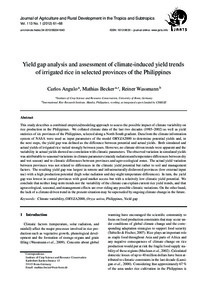| dc.date.accessioned | 2012-09-24T11:30:52Z | |
| dc.date.available | 2012-09-24T11:30:52Z | |
| dc.date.issued | 2012 | |
| dc.identifier.issn | 1612-9830 | |
| dc.identifier.uri | urn:nbn:de:hebis:34-2012082241643 | |
| dc.identifier.uri | http://hdl.handle.net/123456789/2012082241643 | |
| dc.language.iso | eng | |
| dc.publisher | Kassel University Press | ger |
| dc.rights | Urheberrechtlich geschützt | |
| dc.rights.uri | https://rightsstatements.org/page/InC/1.0/ | |
| dc.subject | climate variability | eng |
| dc.subject | ORYZA2000 | eng |
| dc.subject | Oryza sativa | eng |
| dc.subject | Philippines | eng |
| dc.subject | yield gap | eng |
| dc.subject.ddc | 630 | |
| dc.title | Yield gap analysis and assessment of climate-induced yield trends of irrigated rice in selected provinces of the Philippines | eng |
| dc.type | Aufsatz | |
| dcterms.abstract | This study describes a combined empirical/modeling approach to assess the possible impact of climate variability on rice production in the Philippines. We collated climate data of the last two decades (1985-2002) as well as yield statistics of six provinces of the Philippines, selected along a North-South gradient. Data from the climate information system of NASA were used as input parameters of the model ORYZA2000 to determine potential yields and, in the next steps, the yield gaps defined as the difference between potential and actual yields. Both simulated and actual yields of irrigated rice varied strongly between years. However, no climate-driven trends were apparent and the variability in actual yields showed no correlation with climatic parameters. The observed variation in simulated yields was attributable to seasonal variations in climate (dry/wet season) and to climatic differences between provinces and agro-ecological zones. The actual yield variation between provinces was not related to differences in the climatic yield potential but rather to soil and management factors. The resulting yield gap was largest in remote and infrastructurally disfavored provinces (low external input use) with a high production potential (high solar radiation and day-night temperature differences). In turn, the yield gap was lowest in central provinces with good market access but with a relatively low climatic yield potential. We conclude that neither long-term trends nor the variability of the climate can explain current rice yield trends and that agroecological, seasonal, and management effects are over-riding any possible climatic variations. On the other hand the lack of a climate-driven trend in the present situation may be superseded by ongoing climate change in the future. | eng |
| dcterms.accessRights | open access | |
| dcterms.bibliographicCitation | In: Journal of Agriculture and Rural Development in the Tropics and Subtropics. Kassel : Kassel University Press. - Vol. 113, No. 1 (2012), S. 61-68 | |
| dcterms.creator | Angulo, Carlos | |
| dcterms.creator | Becker, Mathias | |
| dcterms.creator | Wassmann, Reiner | |
| dc.description.everything | Gedruckte Ausg. im Verlag Kassel Univ. Press (www.upress.uni-kassel.de) erschienen. | ger |

